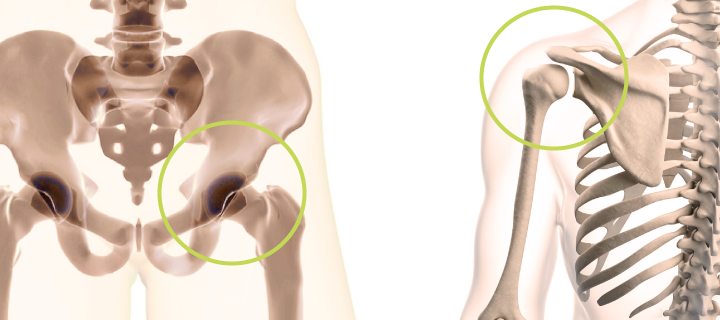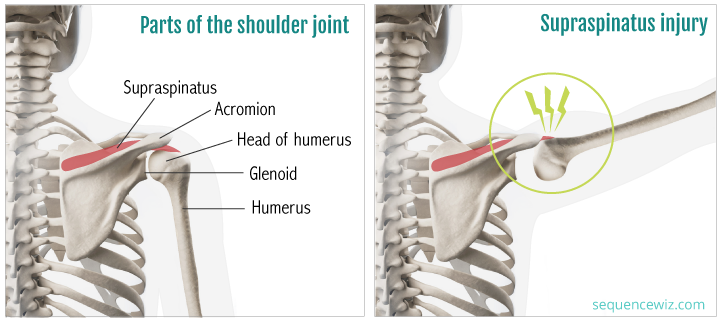A fellow yoga teacher confided in me once: “I had quite a scare in my class yesterday – one of my students had dislocated a shoulder. Luckily, there was a doctor there, who had just popped it right back into place!” Hmm, I thought, I wonder how that happened; and went to his class the following week. I could not lift my arms past my shoulders for three days afterwards. In fact, my shoulders start aching even now at the mere memory of that experience. At the time, I was a fit 20-something year old – what about other older, not-so-fit folks who attended that class?
Unfortunately, in our quest for “power” we sometimes can take it a bit too far and our students’ shoulders suffer as a result. There are several potential issues that can show up and here is why.
Take a look at the structure of the shoulder joint and compare it to the hip joint, both ball-and-socket joints.
As you can see, the socket of the hip joint is much deeper and encloses the head of the femur, which makes it more stable and, as a result, less mobile. You cannot bring your leg up and around, like you can your arm (thank goodness!). In the shoulder joint, on the other hand, it’s not even a socket, it’s more like a shelf, formed by the glenoid cavity on the side and the acromion process on the top. Since the fit is not very tight, the mobility of the shoulder is much greater, which allows us to do all the fun things we want to do with our arms. However, this mobility comes at a price – it makes the shoulder joint less stable and more prone to dislocation and other injuries. Instead of the bony structures, the shoulder joint must be held together by muscles, tendons and ligaments. Their job is to stabilize the joint while allowing for an incredible range of motion.
Another big difference between the two joints is that the hip joint is designed to be a weight-bearing joint, while shoulder isn’t. That means that asking your shoulders to bear weight might be useful for the purpose of muscle strengthening or even improving bone density, BUT it is just not equipped to handle prolonged or repetitive weight bearing activities.
Now let’s take a look at a typical Vinyasa class, that is usually held together by a Sun Salutation sequence which includes all-too-familiar Downward dog – Chaturanga – Upward dog combo.
How many times do you end up doing this sequence within one class? 10? 20? 30? It depends on the teacher. While moving through this sequence, you are asking your shoulder joint to negotiate a delicate dance between flexion, extension, internal and external rotation, all while bearing weight.
What can go wrong?
Have you ever heard of rotator cuff injuries? What it often means is that the tendon of the supraspinatus muscle gets sandwiched between the bones of the shoulder blade and the arm. Supraspinatus is one of four rotator cuff muscles that assists in lifting the arm and stabilizing the shoulder joint.
Supraspinatus impingement usually happens for one of two reasons – mechanical impingement or repetitive microtrauma.
Mechanical impingement happens if you fall down and break the fall with your arm. The head of the humerus will forcefully press into the joint and pinch the tendon(s).
Repetitive microtrauma is an impingement that happens because of the shoulder overuse in the overhead position. It is usually the result of a combination of factors: inherent joint instability, muscular imbalances and repetitive large stresses on the static and dynamic shoulder stabilizers. Let’s say you are someone who has pretty loose shoulder joints (which makes them less stable). You sit at your desk all day typing with your shoulders internally rotated (which over time will cause muscular imbalance). Then at the end of the day you head out to a power yoga class and start loading up your shoulder joints with repetitive Downdogs and Chaturangas. On top of that, you are probably moving fast trying to keep your heart rate up, which makes your shoulders even more vulnerable. Do it enough times and you’ve got yourself some shoulder pain.
On the other hand, if your shoulder joints are not that loose to begin with, you are likely to have difficulty with maintaining proper form as you move in and out of the Downward Dog (which requires external rotation of the shoulders). Repetitive misalignment can also lead to a shoulder injury.
However you look at it, Downward-facing Dog pose is not an easy or “resting “pose, like many students are led to believe. It requires attention to alignment that is hard to achieve when you are moving fast.
Want to put even more stress on your shoulders? Throw in some prolonged weight-bearing moves.
This is an example of another common trend that we see in yoga classes (the one that strained my shoulders all those years ago) – placing too many movements that involve the same joint in a row. We call it cumulative stress. Do you see a problem with this sequence?
Both your shoulders and your wrists are being strained by asking them to bear weight in one pose after another after another without any break in between. As a result, instead of strengthening the muscles, which was probably your original intention, you are stressing and destabilizing your joints.
Cumulative stress is usually a combination of repetitive tasks, mechanical compression and sustained/awkward positions. All of this applies to the sequence above: you are repeating the movement a number of times, you are compressing the joint by asking it to support most of your body weight and you are sustaining this awkward position (by our everyday movement standards) for quite some time.
Potential results?
- Dislocation – the head of the humerus pops out of the shoulder socket
- Tendinitis – irritation of the tendons
- Bursitis – inflammation of the bursa (a fluid-filled sack that serves as a cushion between two rubbing surfaces)
- Impingement of the tendons (which we discussed earlier)
These types of injuries are common in young athletes who use their arms overhead for swimming, baseball, and tennis; and those who do repetitive lifting or overhead activities, such as construction or painting. Now yoga practitioners can joint the ranks!
Listen, I am not saying that you should stop your Sun salutations or Side planks (unless you already have shoulder pain – then you SHOULD stop them!) I am saying that we as teachers have the responsibility to protect our students’ shoulders by limiting the cumulative stress that we place them under. Here is what you can do:
- give the shoulders a break in between weight bearing positions,
- limit the number of Chaturagas and Downdogs,
- increase the challenge for the shoulders and wrists gradually, over time, not in the space of one practice
- be consistent about offering less challenging variations of the poses
- slow things down so that students can pay closer attention to what they are doing.
In words of wise sage Patanjali “Unnecessary suffering must be avoided.” It makes much more sense to prevent shoulder injuries rather then heal them later.
Here are some additional resources on the subject:




Комментариев нет:
Отправить комментарий